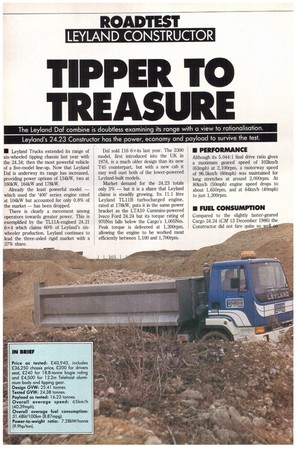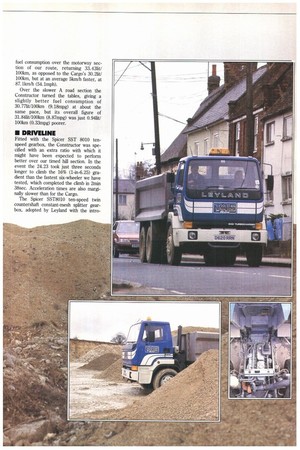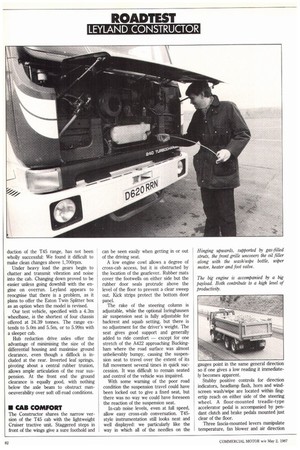TIPPER TO TREASU
Page 82

Page 83

Page 84

Page 85

If you've noticed an error in this article please click here to report it so we can fix it.
The Leyland Dot combine is doubtless examining its range with a view to rationalisation.
Leyland's 24.23 Constructor has the power, economy and payload to survive the test.
• Leyland Trucks extended its range of six-wheeled tipping chassis last year with the 24.34; then the most powerful vehicle of a five-model line-up. Now that Leyland Daf is underway its range has increased, providing power options of 134kW, two at 160kW, 164kW and 178kW.
Already the least powerful model — which used the '400' series engine rated at 104kW but accounted for only 0.8% of the market — has been dropped.
There is clearly a movement among operators towards greater power. This is exemplified by the TL11A-engined 24.21 6x4 which claims 60% of Leyland's sixwheeler production. Leyland continues to lead the three-aided rigid market with a 37% share. Daf sold 116 6x4s last year. The 2300 model, first introduced into the UK in 1978, is a much older design than its new T45 counterpart, but with a new cab it may well oust both of the lower-powered Leyland-built models.
Market demand for the 24.23 totals only 3% — but it is a share that Leyland claims is steadily growing. Its 11.1 litre Leyland TL11B turbocharged engine, rated at 178kW, puts it in the same power bracket as the LTA10 Cummins-powered Iveco Ford 24.24 but its torque rating of 970Nrn falls below the Cargo's 1,005Nm. Peak torque is delivered at 1,300rpm, allowing the engine to be worked most efficiently between 1,100 and 1,700rpm.
• PERFORMANCE
Although its 5.044:1 final drive ratio gives a maximum geared speed of 102km/h (63mph) at 2,100rpm, a motorway speed of 96.5km/h (60mph) was maintained for long stretches at around 2,000rpm. At 80km/h (50mph) engine speed drops to about 1,650rpm, and at 64Iun/h (40mph) to just 1,300rpm.
• FUEL CONSUMPTION
Compared to the slightly faster-geared Cargo 24.24 (CM 13 December 1986) the Constructor did not fare quite so fuel consumption over the motorway section of our route, returning 33.431iti 100km, as opposed to the Cargo's 30.21it/ 100km, but at an average 5km/h faster, at 87.11(rn/h (54.1mph).
Over the slower A road section the Constructor turned the tables, giving a slightly better fuel consumption of 30.77fit/1001an (9.18mpg) at about the same pace, but its overall figure of 31.84k/100km (8.87mpg) was just 0.941it/ 100km (0.33mpg) poorer.
• DRIVELINE
Fitted with the Spicer SST 8010 tenspeed gearbox, the Constructor was specified with an extra ratio with which it might have been expected to perform better over our timed hill section. In the event the 24.23 took just three seconds longer to climb the 16% (1-in-6.25) gradient than the fastest six-wheeler we have tested, which completed the climb in anin 38sec. Acceleration times are also marginally slower than for the Cargo.
The Spicer SST8010 ten-speed twin countershaft constant-mesh splitter gearbox, adopted by Leyland with the intro duction of the 145 range, has not been wholly successful: We found it difficult to make clean changes above 1,700rpm.
Under heavy load the gears begin to chatter and transmit vibration and noise into the cab. Changing down proved to be easier unless going downhill with the engine on overrun. Leyland appears to reocgnise that there is a problem, as it plans to offer the Eaton Twin Splitter box as an option when the model is revised.
Our test vehicle, specified with a 4.3m wheelbase, is the shortest of four chassis offered at 24.39 tonnes. The range extends to 5.0m and 5.5m, or to 5.99m with a sleeper cab.
Hub reduction drive axles offer the advantage of minimising the size of the differential housing and maximise ground clearance, even though a difflock is included at the rear. Inverted leaf springs, pivoting about a central rubber trunion, allows ample articulation of the rear suspension. At the front end the ground clearance is equally good, with nothing below the axle beam to obstruct manoeuverability over soft off-road conditions.
• CAB COMFORT
The Constructor shares the narrow version of the T45 cab with the lightweight Cruiser tractive unit. Staggered steps in front of the wings give a sure foothold and can be seen easily when getting in or out of the driving seat.
A low engine cowl allows a degree of cross-cab access, but it is obstructed by the location of the gearlever. Rubber mats cover the footwells on either side but the rubber door seals protrude above the level of the floor to prevent a clear sweep out. Kick strips protect the bottom door panel.
The rake of the steering column is adjustable, while the optional Isringhausen air suspension seat is fully adjustable for backrest and squab setting, but there is no adjustment for the driver's weight. The seat gives good support and generally added to ride comfort — except for one stretch of the A422 approaching Buckingham where the road surface was almost unbelievably bumpy, causing the suspension seat to travel over the extent of its full movement several times in quick succession. It was difficult to remain seated and control of the vehicle was impaired.
With some warning of the poor road condition the suspension travel could have been locked out to give a fixed seat, but there was no way we could have foreseen the reaction of the suspension seat.
In-cab noise levels, even at full speed, allow easy cross-cab conversation. T45style instrumentation still looks neat and well displayed: we particularly like the way in which all of the needles on the gauges point in the same general direction so if one gives a low reading it immediately becomes apparent.
Stubby positive controls for direction indicators, headlamp flash, horn and windscreen wash/wipe are located within fingertip reach on either side of the steering wheel. A floor-mounted treadle-type accelerator pedal is accompanied by pendant clutch and brake pedals mounted just clear of the floor.
Three fascia-mounted levers manipulate temperature, fan blower and air direction for easy, precise control of the cab environment. Fascia-mounted park brake levers are not particularly unusual nowadays, but the T45-type hand lever remains unique in style, fitting flush with its surrounds when released.
• BRAKING
Brake roller readings recorded a high overall efficiency which was not wholly substantiated by our track tests. Although we obtained a peak retardation of about 0.6g on a dry surface without wheel locking, initial delay in the system's response contributed to longer stopping distances than we might have expected. Overall decekrations were about 0.4g.
The test vehicle did not come equipped with an exhaust brake, nor is one included as an option on the specification sheet. With such a high power-to-weight ratio of 7.28kW/tonne it is an addition that Leyland Daf might well consider.
Daily servicing of coolant, oil and screen wash is simply carried out to the rear of the cab and below the front grille. For a more detailed inspection of the engine the cab may be raised hydraulically by a hand pump through 60°.
• SUMMARY
The extra power supplied by the TL11B turbocharged engine and its wide useable torque band makes the 24.23 Constructor a very easy vehicle to drive. Engine flexibility reduces the need for constant gearchanging while still enabling the vehicle to return quick, economical journey times. Good ground clearance, both front and rear, combine with a third differential to give an off-road performance that is widely appreciated.
Priced at P-36,250, the 24.23 Constructor chassis cab is more expensive than most other 6x4 tippers, but it does offer the best body payload capacity. The cab is about due for an update if the 145 range is to remain competitive in some applications, but for tipper work it is almost ideal.
Rationalisation of the Leyland Daf ranges is inevitable — as inevitable as that of the new company's combined main dealer network — but this is one model that must rate highly as one destined to survive.
LI by Bill Brock




























































































































